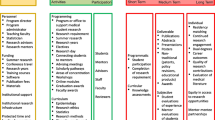Abstract
AIM: The Primary Medical Education (PRIME) program is an outpatient-based, internal medicine residency track nested within the University of California, San Francisco (UCSF) categorical medicine program. Primary Medical Education is based at the San Francisco Veteran’s Affairs Medical Center (VAMC), 1 of 3 teaching hospitals at UCSF. The program accepts 8 UCSF medicine residents annually, who differentiate into PRIME after internship. In 2000, we implemented a novel research methods curriculum with the dual purposes of teaching basic epidemiology skills and providing mentored opportunities for clinical research projects during residency.
SETTING: Single academic internal medicine program.
PROGRAM DESCRIPTION: The PRIME curriculum utilizes didactic lecture, frequent journal clubs, work-in-progress sessions, and active mentoring to enable residents to “try out” a clinical research project during residency.
PROGRAM EVALUATION: Among 32 residents in 4 years, 22 residents have produced 20 papers in peer-reviewed journals, 1 paper under review, and 2 book chapters. Their clinical evaluations are equivalent to other UCSF medicine residents.
DISCUSSION: While learning skills in evidence-based medicine, residents can conduct high-quality research. Utilizing a collaboration of General Internal Medicine researchers and educators, our curriculum affords residents the opportunity to “try-out” clinical research as a potential future career choice.
Similar content being viewed by others
References
www.medschool.ucsf.edu/gme/acgmevisit2005.
Oxman AD, Sackett DL, Guyatt GH. Users’ guides to the medical literature. I. How to get started. The evidence-based medicine working group. JAMA. 1993;270:2093–5.
Ix JH, Shlipak MG, Liu HH, Schiller NB, Whooley MA. Association between renal insufficiency and inducible ischemia in patients with coronary artery disease: the heart and soul study. J Am Soc Nephrol. 2003;14:3233–8.
Gupta S, Bent S, Kohlwes J. Test characteristics of alpha-fetoprotein for detecting hepatocellular carcinoma in patients with hepatitis C. A systematic review and critical analysis. Ann Intern Med. 2003;139:46–50.
Hulley SB, Cummings SR. Designing Clinical Research: An Epidemiologic Approach. Baltimore: Williams & Wilkins; 1998.
Behler C, Shade S, Gregory K, Abrams D, Volberding P. Anemia and HIV in the antiretroviral era: potential significance of testosterone. AIDS Res Hum Retroviruses. 2005;21:200–6.
Beinart G, Damon L. Thrombosis associated with l-asparaginase therapy and low fibrinogen levels in adult acute lymphoblastic leukemia. Am J Hematol. 2004;77:331–5.
Liu R, Nair D, Ix J, Moore DH, Bent S. N-acetylcysteine for the prevention of contrast-induced nephropathy. A systematic review and meta-analysis. J Gen Intern Med. 2005;20:193–200.
Nair D, Shlipak MG, Angeja B, Liu HH, Schiller NB, Whooley MA. Association of anemia with diastolic dysfunction among patients with coronary artery disease in the Heart and Soul Study. Am J Cardiol. 2005;95:332–6.
Young LS, Perdreau-Remington F, Winston LG. Clinical, epidemiologic, and molecular evaluation of a clonal outbreak of methicillin-resistant Staphylococcus aureus infection. Clin Infect Dis. 2004;38:1075–83. Epub April 5, 2004.
Ix JH, McCulloch CE, Chertow GM. Theophylline for the prevention of radiocontrast nephropathy: a meta-analysis. Nephrol Dial Transplant 19:2747–53. Epub August 24, 2004.
Gunn N, Damon L, Varosy P, et al. High CD34+ cell dose promotes faster platelet recovery after autologous stem cell transplantation for acute myeloid leukemia. Biol Blood Marrow Transplant. 2003;9:643–8.
Jun S, Stollman N. Epidemiology of diverticular disease. Best Pract Res Clin Gastroenterol. 2002;16:529–42.
Pham MX, Whooley MA, Evans GT Jr, et al. Prognostic value of low-level cardiac troponin-I elevations in patients without definite acute coronary syndromes. Am Heart J. 2004;148:776–82.
Haberer J, Trivedi NN, Kohlwes J, Tierney L Jr. Clinical problem-solving: a gut feeling. N Engl J Med. 2003;349:73–8.
Haberer JE, Ix JH, Tierney LM Jr. Clinical problem-solving. One foot away. N Engl J Med. 2002;346:1394–7.
Terasawa T, Blackmore CC, Bent S, Kohlwes RJ. Systematic review: computed tomography and ultrasonography to detect acute appendicitis in adults and adolescents. Ann Intern Med. 2004;141:537–46.
Phipps W, Stanley H, Kohn R, Klausner JD. Syphilis, chlamydia and gonorrhea screening in HIV infected patients in primary care, San Francisco, 2003. AIDS Patient Care STDS. 2005;19:495–8.
Phipps W, Kent C, Kohn R, Klausner JD. Risk factors for repeat syphilis infection, San Francisco, 2001–2003, AIDS Patient Care STDS, in press.
Hwang J, Bitarakwate E, Pai M, Reingold A, Rosenthal PJ, Dorsey J. Chloroquine or amodiaquine combined with sulfadoxine-pyrimethamine for uncomplicated malaria: a systematic review. Tropical Medicine and International Health, in press.
Ghaly C, Peabody J. Incentives for increases in research and development for neglected diseases in the developing world. In press.
Chang L, Vidyarthi A, Kohlwes J. Baseline duty hours recorded with timecards: a pre-regulation study of internal medicine residents. Med Edu, in press.
McManus D, Pipkin SS, Whooley MA. Screening for depression in patients with coronary heart disease: data from the heart and soul study. Am J Cardiol. 2005;96:1076–81. Epub August 30, 2005.
Chang LW, Phipps WT, Kennedy GE, Rutherford GW. Antifungal interventions for the primary prevention of cryptococcal disease in adults with HIV. The Cochrane Database of Systematic Reviews 2005, Issue 3. Art. No.: CD004773.pub2. doi: 10.1002/14651858.CD004773.pub2.
Clark BC, Grossman E, White MC, Goldenson J, Tulsky JP. The state of diabetes care in the San Francisco jail. Am J Public Health, in press.
Young LS, Winston LG. Preoperative mupirocin for the prevention of healthcare-associated Staphylococcus aureus infections: A cost effectiveness analysis. Infect Cont-Hosp Epidemiol, in press.
Author information
Authors and Affiliations
Corresponding author
Additional information
The authors have no conflicts of interest to declare.
Calvin Chou, MD, PhD, Kewchang Lee, MD, Patricia Cornett, MD, Sharad Jain, MD, Mary Whooley, MD, Tracy Minichiello, MD, Robert Baron, MD, MPH, Elizabeth Harleman, MD, Thomas Koepsell, MD, MPH, and Richard Deyo, MD, MPH. We also appreciate the input and leadership of Dr. Harry Hollander, the Internal Medicine Residency Director at the University of California, San Francisco.
Rights and permissions
About this article
Cite this article
Kohlwes, R.J., Shunk, R.L., Avins, A. et al. The PRIME curriculum. J GEN INTERN MED 21, 506–509 (2006). https://doi.org/10.1111/j.1525-1497.2006.00438.x
Issue Date:
DOI: https://doi.org/10.1111/j.1525-1497.2006.00438.x




